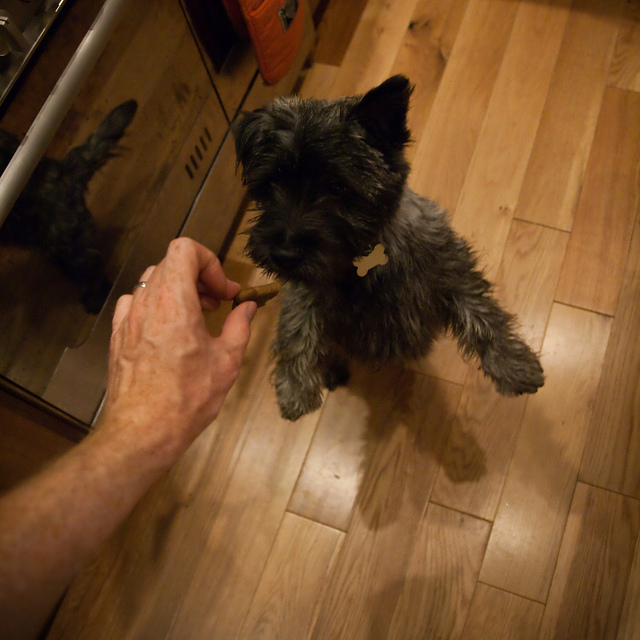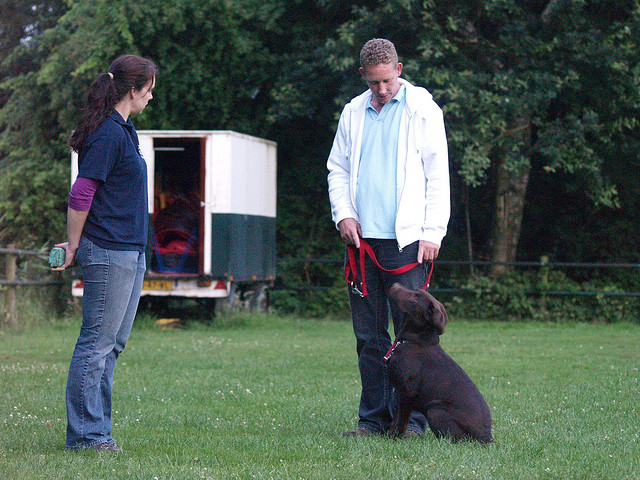Does your dog come when you call no matter what? Tricks are cool but won’t save your dogs life in a dangerous situation, let’s say, near a busy street.
Below are 12 tricks that can help save your dogs life in an unfortunate, tricky or new situation:
Sit – “Sit” is one of the most basic tricks we can teach our dogs. When a dog is in a “sit” position, he knows he is meant to stay sitting until you say otherwise. If you need your dog to just chill out while you take care of something, you can put him in a sit position, knowing he won’t run off and get into trouble while you’re distracted. It’s a perfect command for situations like standing in a crowded place or if you’re loading the car for a trip and need Fido to hang out before getting in.
Lie down – The “lie down” trick is another way to have your dog stay in one place and out of trouble. Teaching your dog to lie down — especially if you teach him to drop to a down position when you signal from far away — can go a long way in keeping him out of trouble. A down position is one of increased vulnerability, so if your dog is getting too rambunctious around other dogs or is too wound up in a certain situation and simply needs to mellow out, a “lie down” command gives him an opportunity to calm down and remember his human is the one who is in control. Like the “sit” command, this is an active command, meaning your dog isn’t just lounging — he should be purposefully staying in one spot, keeping focus on you and waiting for his next command.
Stay – This one is a bit redundant. After all, if you put a dog in a sit or down position, then he shouldn’t need a “stay” command since he should remain in a sit or down until released. But the “stay” command works kind of like a security blanket for both owner and dog — this way everyone knows that the expectation is that the dog isn’t going to move for a while, no matter where you are located, even if that means you are out of sight. And this can be a truly lifesaving command if you need a dog to stay put when there is car traffic or anything happening where a dog moving around could mean he gets injured.Come – This trick is rather obvious. After all, knowing that your dog will return to your side without fail in any situation is a big part of ensuring he will be safe. But getting that “rocket recall” can be tough. When a dog is distracted, or knows that you are much more boring than whatever trouble he is getting into, then getting him to come when called is a challenge. There are different ways to approach it, depending on a dog’s personality, but the best way to make sure your dog beelines back to you when you call is to give him the most amazing treat he can possibly imagine every time he comes back to your side. Whether it is rotisserie chicken, or liver baby food, or tripe, make sure he only gets that treat when he hears, and obeys, the recall command. Then he knows that when he hears the word “come” he’ll get a jackpot of a reward.Your name is the most exciting word in the world – To humans, names are really important. It is embedded in us to use someone’s name to get their attention. Why bother fighting against that compulsion to say a name when needing your dog’s attention? But if it works for us to say the name, we need to make sure it works for the dog to hear his name. Teaching a dog to love his name sets the foundation for everything else in your relationship as it creates a level of trust as well as willingness to learn more tricks. And it can also be a lifesaver when out and about. For instance, if a dog is reactive to other dogs while on leash and his attention begins to zero in on a dog walking toward you on the street, you can say your dog’s name to bring his attention back to you.Sit at street corners –Some dogs just don’t get that streets are dangerous places. Why would they? Streets and the traffic on them are human inventions, and probably seem arbitrary to a dog. But even if your dog doesn’t know that streets are dangerous, he can learn that the spot where a street and sidewalk meet is a place where treats are earned. The curb can become a “cue” for a dog to sit. By teaching a dog to automatically sit when he reaches a curb, you’ll lower the chances that he will trot into the street when a car is coming. Keep in mind, though, that this is a tough trick for a dog to learn, and one you may have to work at for a long time. But if your dog has the personality to master this trick, it can be a real lifesaver.Leave it – If you don’t want your dog getting into something that could kill him, “leave it” is a must-know trick. Many dogs have trouble with the notion of ignoring something that may be just so very tempting. And let’s face it: We really do know what’s better for a dog to leave alone than a dog does. A solid “leave it” command works for keeping your dog from exploring dangerous objects — even other wildlife you come across on walks or hikes — or getting too close to an object or situation that could harm him.Drop it – If you’ve ever had a dog that eats anything and everything he finds, the “drop it” command can be a lifesaver if you find he has scooped up something unsavory or flat-out dangerous. To avoid stomachaches or worse, you’ll want to teach your dog to want to drop something from his mouth the moment you tell him to. For some dog personalities, this might be a big challenge, so make sure that you build a foundation of providing incredible treats every time he obeys the “drop it” command. Your dog will then know that the biggest reward is not what’s in his mouth but what he’ll get if he casts it aside. This command is also excellent for reminding your dog that possessiveness is not a positive personality trait.Wait – This is a great trick for making a dog stop in midstride (click on the photo above to see a video). It is slightly redundant if you already have the “Your Name Is The Most Exciting Word In The World” trick down because with both tricks the intention is to get the dog to stop what he is doing and focus attention back on you.Heel – When your dog is off leash or without a collar and you need him to move along with you somewhere, the “heel” command is a must to keep him safely by your side. It’s also a good command even while on leash when you’re moving through large crowds or in areas with construction or similar danger zones. You can be strict about it, making the heel command one where your dog must walk right up next to you with his head even with your leg, as is the rule in obedience classes. Or you can make it a little less stringent, with the dog knowing he just has to walk by your side until told otherwise. While a solid “heel” command should be enough to keep a dog next to you, I’ve also taught my dog the command “glue.” When he hears “glue!” he sticks his nose on the palm of my hand and keeps it there even if we’re walking or jogging. It comes in handy as our equivalent of holding hands across the street when he is off-leash and there are too many cars around. It’s more for my sense of security than my dog’s, because then I can feel where he is even when I’m looking elsewhere.Focus – If you have a dog that is prone to making independent (and stupid) decisions unless you’re really paying attention, then a “focus” command is a good trick to have at the ready. This is simply a trick that tells the dog, “Ignore everything in the world except me right now.” It is ideal for situations that could get a nervous dog too amped up — such as when walking past other dogs that are giving him the stink eye. “Focus” helps your dog know that he can zone out everything else going on around him (even that mean dog) because you’re the only thing important right now and you’ll handle the rest.Don’t take candy from strangers – It’s sad to say, but you can’t always trust that someone has good intentions when giving your dog a treat. There are horror stories of people handing out poisoned “treats” to dogs. But we don’t have to be as extreme as that in understanding why passing up food from strangers is a smart trick for your dog to learn. This also works for dogs that have food allergies and you don’t want some random person at the dog park feeding them something that’ll cause a reaction. And it also works well to prevent unwanted begging, because let’s face it: A dog that begs is simply being rude, not cute. However, this might be one of the hardest things to teach your dog. And I can’t claim to have taught mine this trick — and I probably never will. Since my dog is fearful of strangers, I have encouraged the idea that humans (even strangers) are walking treat dispensers….




Leave a Reply